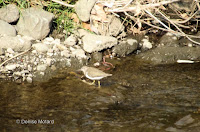SPOTTED SANDPIPER
SPOTTED SANDPIPER – (Actitis macularius) – (See images below)
DESCRIPTION: The Spotted sandpiper is a small shorebird that is the only one with dark spots all over its under parts in breeding plumage. It is brown on top with an orange bill and yellow legs. The bill is about the same length as the head. Sexes are similar. This bird is around 19 cm (7.8 inches) long.
VOICE: https://www.xeno-canto.org/species/Actitis-macularius
NAME: The English name ‘Sandpiper’ stems from ‘sand’, and Latin ‘pipa’, which means to ‘chirp’. The Latin genus name ‘Actitis’ means ‘coast dweller’, and the Latin species name ‘macularius’ means ‘spot’.
HABITAT: Mudflats, This bird has a diversified habitat inland or on coasts, wherever there is shallow water.
DIET: Invertebrates, insects caught on the fly.
NESTING: There is an apparent role reversal between the sexes when choosing the territory, nesting and feeding the chicks. The nest is a scrape on the ground and lined with loose plant material. About four pink eggs are laid, which are incubated by the male. Chicks are able to feed themselves.
DISTRIBUTION: The breeding range encompasses most of Canada and the USA including Alaska. The wintering range is in Mexico, Central and South America. Some individuals have been able to reach Hawaii. (See note below on bird vagrancy.)
Distribution map: https://en.wikipedia.org/wiki/Spotted_sandpiper#/media/File:Actitis_macularius_map.svg
ON PEI: The spotted sandpiper breeds on Prince Edward Island, and is fairly common except in the winter.
CONSERVATION:This sandpiper is widespread, however it is sensitive to alterations to its wetland habitat, for example from pesticides or polluted runoff. It is currently not considered at risk.
NOTES: The spotted sandpiper is constantly bobbing its tail, a behavior which gave it its French name, ‘Maubèche branle-queue’.
Vagrancy: In biology this means an animal going way outside its normal range. For birds, this can happen when there are storms and they get blown off course. On other times, the bird simply wanders in a different direction than usual. Here’s an article about vagrancy in birds.
SIMILAR SPECIES: The spotted sandpiper has a sister species, the Common Sandpiper (A. hypoleucos), and together they make up the genus Actitis. They replace each other geographically; stray birds may settle down with breeders of the other species and hybridize. Here’s a photo below of a common sandpiper, as a comparison with the spotted sandpiper.
Other similar species: Solitary Sandpiper, Lesser Yellowlegs, Least Sandpiper
REFERENCES: https://www.borealbirds.org/bird/spotted-sandpiper
http://www.nhptv.org/natureworks/spottedsandpiper.htm (New Hampshire PBS)
https://www.audubon.org/field-guide/bird/spotted-sandpiper
https://www.allaboutbirds.org/guide/Spotted_Sandpiper/id
https://www.mba-aom.ca/jsp/toc.jsp (Maritimes Breeding Bird Atlas)
https://en.wikipedia.org/wiki/Spotted_sandpiper
DESCRIPTION: The Spotted sandpiper is a small shorebird that is the only one with dark spots all over its under parts in breeding plumage. It is brown on top with an orange bill and yellow legs. The bill is about the same length as the head. Sexes are similar. This bird is around 19 cm (7.8 inches) long.
VOICE: https://www.xeno-canto.org/species/Actitis-macularius
NAME: The English name ‘Sandpiper’ stems from ‘sand’, and Latin ‘pipa’, which means to ‘chirp’. The Latin genus name ‘Actitis’ means ‘coast dweller’, and the Latin species name ‘macularius’ means ‘spot’.
HABITAT: Mudflats, This bird has a diversified habitat inland or on coasts, wherever there is shallow water.
DIET: Invertebrates, insects caught on the fly.
NESTING: There is an apparent role reversal between the sexes when choosing the territory, nesting and feeding the chicks. The nest is a scrape on the ground and lined with loose plant material. About four pink eggs are laid, which are incubated by the male. Chicks are able to feed themselves.
DISTRIBUTION: The breeding range encompasses most of Canada and the USA including Alaska. The wintering range is in Mexico, Central and South America. Some individuals have been able to reach Hawaii. (See note below on bird vagrancy.)
Distribution map: https://en.wikipedia.org/wiki/Spotted_sandpiper#/media/File:Actitis_macularius_map.svg
ON PEI: The spotted sandpiper breeds on Prince Edward Island, and is fairly common except in the winter.
CONSERVATION:This sandpiper is widespread, however it is sensitive to alterations to its wetland habitat, for example from pesticides or polluted runoff. It is currently not considered at risk.
NOTES: The spotted sandpiper is constantly bobbing its tail, a behavior which gave it its French name, ‘Maubèche branle-queue’.
Vagrancy: In biology this means an animal going way outside its normal range. For birds, this can happen when there are storms and they get blown off course. On other times, the bird simply wanders in a different direction than usual. Here’s an article about vagrancy in birds.
SIMILAR SPECIES: The spotted sandpiper has a sister species, the Common Sandpiper (A. hypoleucos), and together they make up the genus Actitis. They replace each other geographically; stray birds may settle down with breeders of the other species and hybridize. Here’s a photo below of a common sandpiper, as a comparison with the spotted sandpiper.
Other similar species: Solitary Sandpiper, Lesser Yellowlegs, Least Sandpiper
REFERENCES: https://www.borealbirds.org/bird/spotted-sandpiper
http://www.nhptv.org/natureworks/spottedsandpiper.htm (New Hampshire PBS)
https://www.audubon.org/field-guide/bird/spotted-sandpiper
https://www.allaboutbirds.org/guide/Spotted_Sandpiper/id
https://www.mba-aom.ca/jsp/toc.jsp (Maritimes Breeding Bird Atlas)
https://en.wikipedia.org/wiki/Spotted_sandpiper
 |
| Spotted sandpiper, PEI, Roberta Palmer |
 |
| Common sandpiper, Tokyo, Japan |